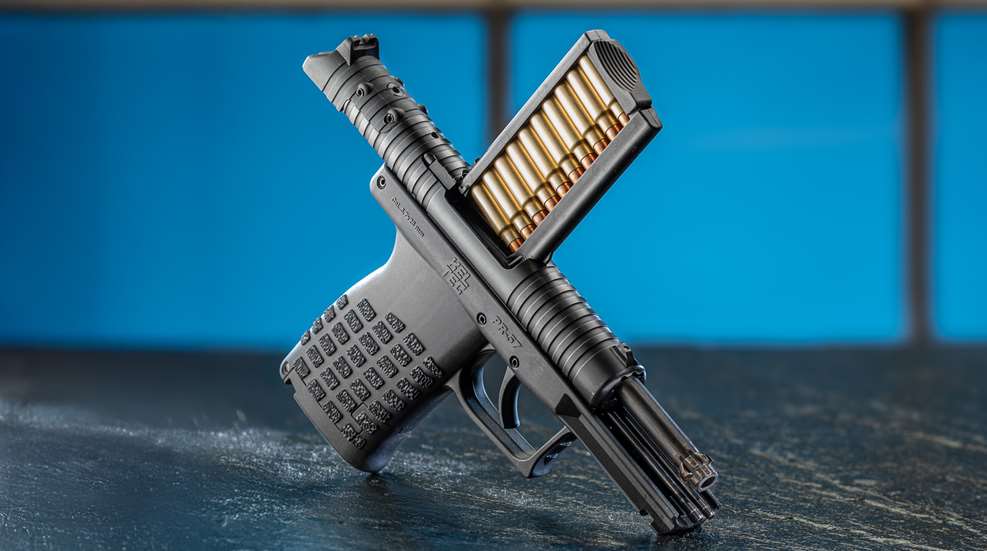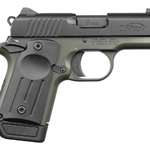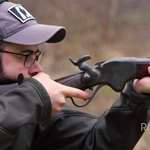
True story: My first conversation regarding the new PR57 occurred in the form of a guessing game initiated by a colleague approximately six months prior to its public launch. He described the upcoming pistol in as much detail as he knew at the time; my task was to try to divine its maker. The longer his description went on, the more unorthodox the firearm in question was revealed to be, the more my personal interest in it grew and the more convinced I became that the curious gun in question was a KelTec.
Got it in one! And the simple reason for my success is that the man at the company’s helm, George Kellgren, is as close to an auteur as the firearm industry currently has. When you encounter one of his creations, even just conceptionally, you know it—and bucking convention has long been Kellgren’s stock-in-trade—the PR57 just had that distinctive combination of lightweight utility and inventive creativity.
An unusual juxtaposition of both very old and highly modern attributes, the KelTec PR57 is a concealed-carry pistol chambered for the ascendant but still decidedly non-mainstream 5.7x28 mm FN cartridge that utilizes an unconventional rotating action, locking lugs arrayed forward on the barrel and a cylindrical slide. But most peculiarly of all, it eschews the detachable box magazine that has been present on basically every semi-automatic handgun for the past 100 years in favor of exclusively employing a 19th-century-style stripper-clip-fed blind internal magazine.

If all that sounds a bit strange to you, that’s because it absolutely is—for this day and age, at least. You know you’re dealing with something more than a little bit “out there” when the most recent contemporary analog for it that comes to mind is probably the M1907 Roth-Steyr, a pistol adopted for military service by an empire that hasn’t existed for 107 years now. But, while oddness can definitely have its charms—just ask my wife—being different isn’t a virtue in and of itself, so what about the PR57 actually makes it a worthwhile idea? Let’s take a closer look at what KelTec did in designing the gun and why it chose to go its own way in doing so.
The pistol’s first deviation from the norm? Size. Right now isn’t just a good time to develop an interest in the 5.7x28 mm FN, it’s the best time in the little cartridge’s entire existence, as we’ve likely seen more new introductions of 5.7 mm-chambered firearms (and also many new ammunition options) during the past three years than we did in the three decades that preceded them. KelTec itself is unquestionably numbered among the cartridge’s fans, previously chambering it first in the company’s P50 large-format pistol and then more recently as an option for the GEN3 SUB2000.
But despite all the new additions to the market, the PR57 is one of the very first 5.7 mm pistols sized expressly for easy carry—as it is the smallest and thinnest by a nose and the lightest by a sizable margin. From the rimfire P17 to the deep-cover P32 to the full-power P15, KelTec loves being able to claim “lightest weight in its class” status, and this new gun might be the most extreme example yet. Measuring 7.13" long and 5" tall, the PR57 more or less duplicates the height and length of the famously carry-friendly Glock 19, yet, at only 14 ozs., it weighs nearly 10 ozs. less than the G19 empty, and that disparity only increases when you factor in the KelTec’s sub-20-oz. weight with a full complement of 5.7 mm onboard.
The PR57’s polymer frame is deceptive in that it almost looks “normal” at first glance. A 21st century semi-automatic not having a detachable magazine is so foreign a notion that I’ve now witnessed two separate people handle the gun for 30 seconds or more before even noticing its absence—your mind just expects it to be there and fills in the blanks when it’s not. Yet ask them to load the gun, and the light bulb suddenly clicks on.

There is no well in the frame for insertion of an external magazine, and the lack of such a removable box eliminates the need for an associated button that would release it. As a result, the lone control on the pistol’s frame is a low-profile, left-side slide-stop lever for a right-hander’s thumb. The owner’s manual specifically mentions that, for reliable function, this control should not be used as a slide release; rather, always grasp and “slingshot” the slide to close the action.
With the slide locked back on an empty gun, its enlarged ejection port provides unencumbered access to the blind magazine. Rounds can then either be singly thumbed or force fed 10 at a time into the magazine with the assistance of two included plastic stripper clips (additional clips are available aftermarket). That’s right, the KelTec provides that rare occasion when you can say the pistol comes with “clips” without sounding ignorant.
Because the 5.7 mm is more of a shortened intermediate rifle cartridge and not a typical handgun cartridge, it generates energy by way of a small-caliber projectile traveling relatively quickly, and its svelte case design allows rounds to stagger stack within a handgun’s frame without the grip being impractically girthy as a result. This is even more true in the case of the PR57; by dispensing with the box magazine, KelTec was able to keep the pistol’s width to just 0.97" despite its impressive payload. KelTec’s literature lists the firearm’s capacity as 20+1, which doesn’t really make sense for a gun that can’t be topped off in the traditional fashion, however, I was consistently able to get 21 rounds to seat properly in the magazine of the test pistol anyway, so the end result is the same.

Loading rounds into the clips is not a difficult operation after about 30 seconds of practice. The key is (after first sliding the thumb plunger into position ahead of the top round) to feed the rear of each cartridge in first, after which the bullet end can simply be swung into place. Repeat until full. Small alcoves have been cut into the front and rear of the ejection port to act as guides for the clips; to properly seat a filled clip atop the slide, first hook the lip on the face of the clip into the depression in the front of the port and then rock the rear end of the clip into place using a motion not unlike seating an AK or M1A magazine.
Lastly, with one hand supporting the clip, just press down on the plunger until the clip is empty and all cartridges have been deposited within the internal magazine. Close the slide, and the gun is ready to fire. Unfortunately, once rounds are loaded into the internal magazine, there is no provision for getting them back out again without first running each through the PR57’s chamber, a less-than-ideal circumstance compounded by the pistol’s lack of a manual safety.

As with much of KelTec’s handgun catalog, grip texturing on the PR57 takes the form of the company’s grenade-style Gator Grip pattern that stands proud of the sides of the pistol’s frame. Like the P15 before it, each individual block of the texture has also been stippled for greatly improved purchase. Each pistol’s serial number is engraved on the left side of its internal aluminum receiver and is visible through a small window in the frame. A single Picatinny rail slot forward on the dustcover facilitates the use of a light or a laser.
Despite the lack of a removable magazine, the bottom of the grip can be separated from the rest of the frame should maintenance to the magazine well or the magazine spring be required—this process involves tapping out a pin with a 1/8" punch. A pair of windows have also been cut into the heel of this part; when the gun is fully loaded and the magazine spring is fully compressed, not only can the polymer follower be easily seen, but a small portion even physically protrudes through the holes for tactile confirmation.
The PR57 functions via a short-recoil-operated, locked-breech design; while its rotary action is far from unique, it is much further from commonplace, however, given that the configuration requires less slide mass, it makes a lot of sense in a 5.7 mm carry gun. Upon ignition, the slide and barrel recoil together rearward for about 1/8", at which point camming surfaces in a stationary part that KelTec calls the trunnion interact with a barrel cam lug in the bottom of the barrel to rotate it about 22 degrees counterclockwise. This slight rotation is enough to disengage both eight small locking lugs spaced equidistantly around the circumference of the front of the barrel and a larger one just forward of the trunnion from their respective mortises in the slide, allowing it to continue rearward.
A captured recoil-spring assembly with tandem, side-by-side, full-length guide rods—an arrangement that allows for a more compact design than a single larger guide rod would—then returns the slide to battery following extraction and ejection. The former is accomplished by a small external extractor at 2 o’clock on the slide; the latter action is performed by a fixed ejector mounted within the frame that protrudes through the left side of the bolt face when the spring bottoms out.
An enclosed hammer-fired ignition system yields a double-action-only trigger pull. I saw a few early videos about the PR57 maligning its trigger, and after several months behind the gun, I believe those complaints were unfair and/or misguided. The pull is unquestionably long—with about 1/8" of take-up before resistance is encountered, followed by another 3/8" of travel until the sear releases—but it is not overly heavy, my test sample’s trigger broke on average at 4 lbs., 8 ozs., of pressure, and there is very little perceivable stacking before the break. The reset is also noticeably long, as it requires taking the trigger all the way back to the point where resistance was first met, but, overall, I would rate the pistol’s trigger as smoother, if slower, than most.

The PR57’s aesthetic is distinctive enough that it will probably prove to be polarizing, mostly due to the cylindrical cross section of the 4140 steel slide, but I don’t mind it. And the rounded top end allows considerably less metal to be used, resulting in a much trimmer and lighter firearm, while also requiring less machining and lowering manufacturing costs. The rear clip guide doubles as a visual loaded-chamber indicator.
Consisting of a U-notch rear incorporated into the removable slide cover and a fixed post front, the pistol’s three-dot sights are minimal in size but easy enough to pick up. Grasping grooves 1/8"-wide span the entire circumference of the slide both fore and aft of the ejection/loading port, providing ample real estate for manual manipulation. KelTec also includes a plastic plate with each PR57 that facilitates the direct mounting of Shield-pattern optics.
The company website cites the PR57’s 4140 steel barrel as 4" long, but my sample pistol’s barrel measured approximately an 1/8" shy of that. This positions it as the shortest-barreled pistol among the current crop of 5.7 mm handguns, which should at least marginally impact its terminal ballistics, but we’ll get to that once we hit the range. KelTec rifles the PR57’s barrel at a 1:7" twist rate, somewhat faster than the nearly universal 1:9" rate used by the rest of the industry’s 5.7 mm-chambered pistols.
KelTec boasts that the PR57 has the simplest takedown process on the market, and it’s difficult to really quibble with that. Pressing forward on the trigger from behind is all that’s necessary to free the slide from the frame, allowing it to be pushed forward off its rails. From there, slightly depressing the recoil-spring assembly allows it to be lifted out of the way, permitting access to the trunnion and barrel, both of which can be removed by simply picking them up (one at a time to avoid dropping the trunnion) with your fingers.

Reassembly is just disassembly in reverse, but with the added note that, once the slide is back on the frame, you’re going to need to lock the action open and then push forward again on the trigger. Otherwise, the slide won’t be retained and will just slip off the frame again. The company recommends that the chamber be given a light coating of lubrication prior to use.
On the range, the PR57 displayed excellent accuracy. The three 5.7 mm loads selected to undergo Rifleman’s formal accuracy protocol were Fiocchi’s 35-grain Hyperformance offering, FN’s 40-grain SS197SR sporting cartridges and Speer’s 40-grain Gold Dots. Each performed more than well enough for practical use, but the Fiocchi was the test gun’s clear favorite, posting a five-group average of 1.41" at 15 yards.
An additional 100 rounds of Federal 40-grain American Eagles were also run through the gun to gauge reliability, and, during the entire evaluation period, I did not encounter a single stoppage. Compared to 5" 5.7 mm guns tested in the past, the PR57’s velocities were about 25 f.p.s. slower, but this was, frankly, less of a decrease than expected.
Shooting was pleasant and practice was enjoyable, which can’t be said of too many 14-oz. carry guns. Despite being the lightest pistol in its class, the 5.7 mm’s felt recoil is more like that of a rimfire version of the .22-cal. than the centerfire cartridge it is. If the rotating barrel was causing the pistol to torque in my hand when fired, it was negligible.
At the current moment, a 22-oz. Kimber Mako is my primary CCW, and it accompanied me on each range trip with the PR57. Despite being a full half pound lighter, follow-up shots with the KelTec were so much more immediate than with the 9 mm Luger that I regret not having a shot timer on hand that would have let me quantify the difference, and the speed with which rapid-fire hits could be scored on my range’s 12"x20" steel targets at 25 yards was immensely gratifying.
Manually loading 20 rounds into the gun one by one took just shy of a minute. With very little practice, I got my average using the pair of pre-loaded clips down to around 15 seconds. I really didn’t find the process of refilling the stripper clips to be any more tedious than the standard annoyance associated with filling a more typical box magazine—while being noticeably easier on the thumbs.
If you are at all recoil-averse, the PR57 will be drastically more enjoyable than shooting a micro-compact 9 mm, and I did not find the recoil springs to be particularly heavy, so you don’t need to have a gorilla grip in order to operate the gun. However, while light-recoiling, be aware that 5.7x28 mm FN through a short barrel is a screamer. Overall, when chambered in a pistol, 5.7 mm makes for a capable-yet-unintimidating carry option—and the gun that you can more comfortably control is also the gun that you can more accurately fire—just as long as you’re willing to prioritize capacity over kinetic energy.
Which brings us to what may be a fly in the ointment for some. Reloading the PR57 during an emergency, using either method, is going to be far too difficult to be relied upon when the adrenaline is pumping and your fine motor skills fail you. So, by choosing the high-capacity 5.7 mm cartridge and chambering it within a more-difficult-to-reload firearm, KelTec is essentially banking on the premise that the 21 rounds on you will be all that will ever be needed to get through whatever dangers life puts in your path.
To be fair, this probably isn’t an unsafe assertion, statistically speaking, but it is understandably one that some concealed carriers will be unwilling to make. If you’re the type who feels compelled to practice tactical reloads endlessly in your free time and won’t leave home with anything less than two spare magazines on your person, then this likely isn’t the gun for you. But, again, the belief that to do anything less is to be unprepared is, thankfully, not really supported by reality.
George Kellgren endeavored to design the smallest and lightest 5.7x28 mm FN-chambered semi-automatic pistol possible, and in doing so he was willing to allow function to dictate form, even if the end result deviated substantially from the norm, which it does. Only time will tell whether KelTec’s Gen 2 Roth-Steyr strikes a chord with enough shooters to be considered a success, but I like its chances. Some will certainly spurn the PR57 for that differentness, but I’ve also encountered enough people curious about its off-beat way of doing things to predict that more than a few of them will undoubtedly reward the company for its willingness to row into the prevailing winds rather than be pushed around by them.
Thanks to an MSRP of only $399—a far cry from the decades when a $1,200 FN was the only option in 5.7 mm-chambered pistols—KelTec’s PR57 provides cost-conscious shooters with a venue through which to discover the joys of the cartridge for themselves. And, to this day, I have yet to see anyone who has been able to resist the little cartridge’s charms after actually pulling the trigger on one.
Case in point: I opened with a true story about the PR57, so it’s only fitting that I close with another. As I was nearing the end of my final range trip with the gun, the owner of the range I use pulled up in his truck. At first, he was not overly enthused about the KelTec when I showed him what I had been shooting, but I had exactly 40 unspent rounds left, and I eventually convinced him to help me out by polishing them off. Despite his initial disinterest, by the end of loading and unloading the gun twice, he turned to me and said, “Yeah, I guess I’ll need to buy one.”




































